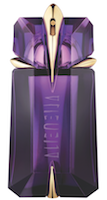The attention to detail in the bottle design echoes the attention to details given to fragrance packaging, where margins are made on the perceived value of the luxurious vessel.
So many liqueurs sit in the feminine space of guilty pleasure. Baileys Chocolat Luxe is clearly about  indulgence and richness. In the brand communications the dark bottle is wrapped in gold foil to mimic the opening of a premium dark chocolate tablet, thus capturing very well that known ritual and all its emotional resonance. The bottle itself breathes chocolate indulgence.
indulgence and richness. In the brand communications the dark bottle is wrapped in gold foil to mimic the opening of a premium dark chocolate tablet, thus capturing very well that known ritual and all its emotional resonance. The bottle itself breathes chocolate indulgence.
The new bottle design for Jago’s vanilla cream liqueur also shows a more feminine and seductive positioning against its more generic original presentation. It now looks more premium, and more generous. The bottle shape is tapered and characterful, unlike the first tall, straight bottle.
The graphic treatment of the bottle shoulders with delicately interlaced pattern work is definitely a more seductive approach than its stiff predecessor. On its relaunch it went from looking like a generic gender-neutral coffee liqueur to something softer and more indulgent: a reappraisal of the core market ingredients and a complete U-turn from its competitors.
Mix-up looks sharp
An old classic can also gain nobility by association by blending a premium variant of the liqueur with a more premium spirit. Grand Marnier Quintessence blends grand champagne cognac with Grand Marnier.
Costing a modest £500 (compared to other limited editions) it is marketed in a very cognac-like, yet modern, crystal bottle, reminiscent of Grand Marnier’s bottle proportions.
Very beautiful, achieving the brand halo effect, and as far away from affordable liqueur as one can be. Will it make the brand inspirational and boost its stock in premium cocktails bars? Does it reinvigorate the brand and deliver a message of premiumisation?

The smell of success
Looking at this from a different angle, and again from the French market, there are many parallels that can be drawn between successful liqueurs and fragrances. Like fragrances, the most successful liqueurs are complex blends of ingredients, elegantly bottled and communicating not the hero ingredients but the brand values.
Unlike the relatively stagnant liqueur industry, aspirational fragrance brands from fashion houses have tapped into the liqueur heritage in a number of surprising ways – Thierry Mugler’s perfume liqueur is a prime example of this.
Mugler took three of its most feminine scents – Angel, Alien (right) and Womanity – and transformed themvia a short barrel ageing.
The process allows the perfumes to ferment for six weeks in exactly the same oak or toasted cherry wood barrels used to produce fine liqueurs. In their new form, each fragrance reveals new aromas.
This creativity in liquid development might just spark some new ideas.
We should also remember that the hugely successful Hpnotiq was inspired by a blue perfume bottle which its creator saw in Bloomingdale’s. The brand worlds of perfume and spirits of all categories always intertwine.



